O RIBEIRO
WHAT TO DO
Museum of Traditional Galician Costume and the Estanislao Reverter Automobile Museum.
We leave Ourense towards Ribadavia on the A-52 highway.
Before arriving at Ribeiro there is the option of taking the exit towards Pontevedra to Santa Cruz de Arrabaldo to visit the Santa Cruz de Arrabaldo-INORDE station. This renovated former train station houses two interesting museums: Museum of Traditional Galician Costume and the Estanislao Reverter Automobile Museum.
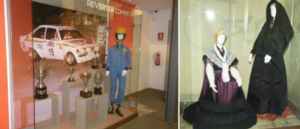
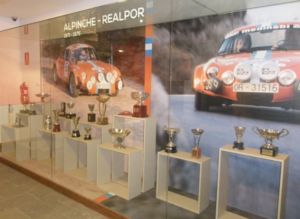

Thermal Area
Or at the same exit go to the town of Barbantes Estación and on one of the banks of the Miño River there is the Thermal AreaThis is a thermal and leisure area with a free use enclosure consisting of a large garden area and 3 pools of thermal water.

In the surroundings of the Thermal Area of Barbantes is the first permanent circuit of Sport Orientation that exists in Galicia. In addition, the Paseo Termal do Miño, a linear route of 4.7 km that connects Razamonde with Barbantes Estación, passing by Laias, with beautiful stretches of footbridges.
Along the same road is the Laias Spa,and in addition to its thermal offer, it is the starting point of the ECOBARCO.
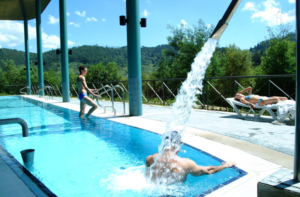
From here we head to Ribadavia, capital of the oldest and most famous wine region of Galicia, the Ribeiro.
Ribadavia
It is worth mentioning its historical complex with beautiful buildings that evoke a glorious past, highlighting numerous Romanesque, Gothic and Baroque churches,the convents of Santo Domingo and San Franciscoand of course, its fortress (fief of the Sarmiento family) and its walls.
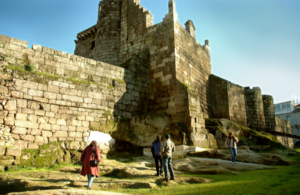
Once located in the Praza Maior the first step is to approach the Pazo de los Condes, which currently houses the Tourist Office to obtain information or use the audio guide service and from where you can access the castle of the counts of Ribadavia and the Xunta de Galicia Information Center for a small fee.
Ribadavia is located within the network of Jewish quarters in Spain, the Jews contributed decisively to the economic prosperity of the region and specialized in the wine trade and in the administration of goods and revenues. In the village of Ribadavia, the Jewish community lived in the Rúa da Xudería (now Merelles Caula) and in the streets of the Porta Nova (XII-XVI century).

mandatory stop is the Tafona da Herminia to taste the Hebrew Sweets and visit the interesting Ethnological Museum,located in the Rúa de Santiago, in a mansion known as Pazo de Baamonde or Casa de la Fundación.

From the Bridge of San Francisco, the Avia river walk starts, which goes between bridges and mills to the Miño river, where a valley of great beauty, Valparaiso, opens up.
Being in Ribeiro, the wine capital of Galicia, it would be interesting to visit some of the wineries of this appellation. We can request the brochure of the Ribeiro Wine Routeat the Ribadavia Tourist Office,to learn more about its wines, history and landscapes.
Galician Wine Museum
A visit to the Galician Wine MuseumThe Rectoral de Santo André de Campo Redondo, one of the most important historical buildings in Europe used since ancient times for the production of wine for Santiago de Compostela, is located in the Rectoral de Santo André de Campo Redondo, 3.5 km from Ribadavia on the OU 211.
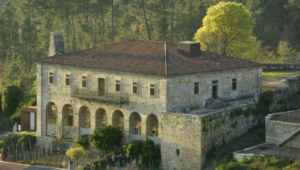
prexigueiro thermal baths
On the OU-801 towards Cortegada, we find a jewel of pre-Romanesque Ourense, the chapel of San Xés de Francelos,and in Prexigueirolas thermal baths of the same name, a thermal circuit is a dream place, totally surrounded by nature.

Cortegada Thermal Village
La Villa termal de Cortegada a parte de un moderno balneario también tiene un antiguo balneario en un palacete modernista sobre las aguas de río Miño, a su lado el agradable Mirador Coto da Pena con unas bonitas vistas del río.

Melón and Tourón Pools
Otra opción es continuar por la autovía A-52 hasta Melón, destaca el monasterio cisterciense de Santa María, y las Pozas de Melón y Tourón, una zona de baño y paseo con impresionantes pasarelas y cascadas.

Castrelo de Miño
Desde Ribadavia, Castrelo de Miño queda muy cerca, su mejor monumento lo constituye la iglesia de Santa María de Castreloof Romanesque style. Its airy location on top of a castro gives it a special majesty and beautiful views. A short distance away is the Castrelo de Miño Nautical Park, an ideal place for nautical and leisure activities.
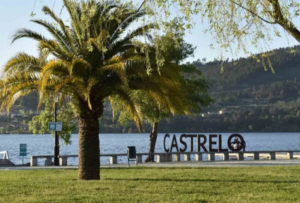
Balneario de Arnoia Caldaria
Arnoia, posee un importante balneario. From there along a fluvial promenade we reach the pleasant As Poldras Recreational Area, a perfect bathing area for the summer. The Romanesque priory and church of San Salvador and the historic village of A Ponte also stand out.

Address Carballiño
Back in Ribadavia, we take the OU-504 road towards Carballiño.
En nuestro trayecto veremos el desvío a Carballeda de Avía por la OU-0306, allí se encuentra dentro de la Ruta dos Muíños el área recreativa de los Muiños de A Veronza, en un pequeño paseo podemos disfrutar de la naturaleza y visitar varios molinos de río.
The Pena Corneira Natural Monument is located between the municipalities of Leiro, Carballeda de Avia and Avión. The ascent can be done by car following the OU-0306 towards Avión we will make the detour to Lamas, arriving at a very close point of the rock “pena”, the viewpoint of O O Outeiral and the recreational area of Pena Corneira. (from here you can go directly to Leiro).
From here we will take the OU 212 towards Beade, with a detour to Berán (a historic wine-growing area with a spa of great tradition). In Beade we find what was one of the main churches and priories of the Order of Malta in the Iberian Peninsula.
Next to the Church of Santa Maria de Beade is its spectacular Stations of the Cross known for the drawings of Castelao, considered the greatest exponent of Galician literature.

In addition,the Ridiomas forest (Beade), owned by a cultural-ecological association that seeks its regeneration.
From Beade we will follow the road that takes us to Carballiño following the course of the Avia river, with detours to picturesque traditional wine villages and beautiful medieval villages surrounded by terraced vineyards, some of them stand out as Vieite or Barzamedelle with the gothic bridge of Ponte San Clodio.
We arrive at Leiro, an attractive and touristic village, the Avia river on its way, allows the enjoyment of the fantastic promenade and recreational area of Salgueiral, with an original suspension bridge.
Nearby is the Monastery of San ClodioToday it has become the first monument hotel and the first wine therapy spa in Galicia. We will be able to visit a building with centuries of history and enjoy treatments that include the use of grapes and wine.
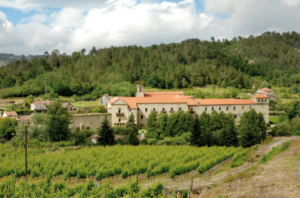
Returning to Leiro, we take a detour that will take us to Pazos de Arenteiro.located a few kilometers away. This town is an important monumental complex, where the nobility of its constructions in churches, pazos and emblazoned houses of those who became rich with wine stands out, in addition to its natural environment of great beauty. Especially beautiful is the walk along the Arenteiro river, from the medieval bridge to the well known as Pozo dos Fumes.
Back on the OU towards Carballiño. We will take a detour at the village of Partovia, where we will find the historical spa of Las Caldas de Partoviay from there we can go to the Archaeological Park of the Castrexa Culture in San Cibrao de Lasone of the largest castrexos sites in Galicia. In addition to the There are guided tours of the archaeological site.

Carballiño
Carballiño is a bustling town with a great thermal tradition, the magnificent Templo de la Veracruz,a work of Antonio Palacios, the Gran Balneario and the Parque.

In the large park that the town enjoys, there are two obligatory stops, theGran Balneario and the Arenteiro Ethnographic Park, formed by a group of mills and the miller’s house. At his side “a Pena dos Namorados”.
We cannot leave Carballiño without tasting its famous octopus, which has its own festival, and the cañas, a delicious dessert.

Around the town are the wine-growing villages of Banga, Moldes or Cabanelas, with important Romanesque churches.
After visiting Carballiño, we must go to the Monastery of Santa María de Oseira. (15 km from Carballiño), located in Cea, a town famous for its bread and traditional ovens. The Monastery of Oseira is an architectural jewel hidden in a beautiful natural setting that we can visit guided by the friars who still live there.












